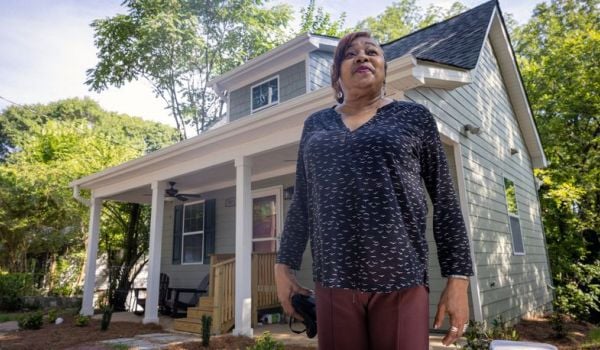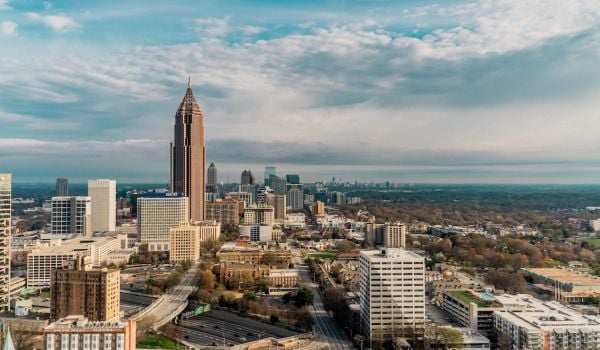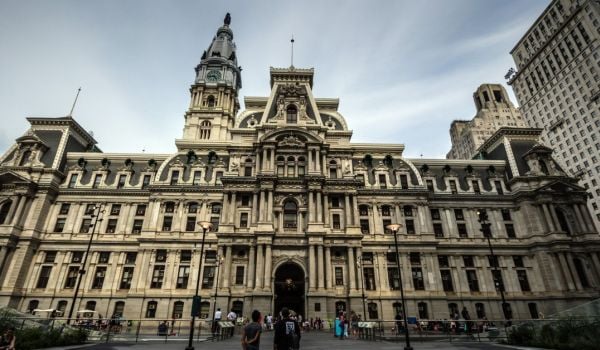Destiny came calling for Ed Smith.
Hired this summer at Invest Atlanta, the city’s economic development authority, Smith is the city’s first “Chief Opportunity Zone Officer.” The role didn’t exist until this year. Funded by the Rockefeller Foundation, it’s named after the new Opportunity Zones tax break that didn’t exist until the end of 2017. But Smith’s entire life seems to have been preparing him to take on the job.
Smith grew up just south of Atlanta, in Jonesboro, Georgia, where he went to Jonesboro High School. He earned his economic development stripes in New York City, working for the Brooklyn Navy Yard Development Corporation. He was the project manager for the nonprofit’s first deal under the federal EB-5 Immigrant Investor Program. The deal raised $60 million from foreign investors for a renovation of a 215,000-square-foot industrial building that was used during World War II as a machine shop for the United States Navy and had been vacant for decades.
“When that deal went to market I was fascinated by the process of leveraging our public assets at the Navy Yard to raise private capital and engage in public-private partnerships,” Smith says.
The Brooklyn Navy Yard went on to do six more EB-5 deals (so far), raising $339 million from foreign investors — mostly from China. It’s still considered an exemplar of the EB-5 program’s goal of creating jobs. Smith went on to get a doctorate from the University of Delaware, after doing his dissertation on the program. He then went to work for an EB-5 consulting firm, writing business plans and offering other advisory services for EB-5 projects across the country. He eventually launched his own consultancy.
Raising capital from private investors takes a very particular set of skills, and there are very specific laws and regulations around it — which is why EB-5 is the closest predecessor of Opportunity Zones. Also known as the “buy-a-visa” program, EB-5 offers permanent U.S. residency visas to foreign private investors and their family members in exchange for investments in eligible projects. And now Opportunity Zones offer potentially unlimited tax breaks on capital gains income to private investors in exchange for making eligible investments in the 8,762 designated Opportunity Zone census tracts across the country.
Some consider those benefits for investors to be rather over-generous, and projects under EB-5 and now the new Opportunity Zones have drawn scrutiny for not reflecting the intent of the subsidy given. For every Brooklyn Navy Yard, there’s also a Hudson Yards — “a supersized suburban-style office park, with a shopping mall and a quasi-gated condo community targeted at the 0.1 percent” that got $1.2 billion in EB-5 financing.
Smith has seen EB-5 at its best, but he’s also keenly aware of its worst. His job now is to help make sure Atlanta’s Opportunity Zone story is more Brooklyn Navy Yard than Hudson Yards. Under the Tax Cuts and Jobs Act of 2017, state governors had until April 2018 to select a limited number of eligible tracts in their states. Outgoing Governor Nathan Deal’s office selected 26 Opportunity Zone census tracts in Atlanta, home to some 85,000 residents — almost 20 percent of the city’s population. Those tracts are mostly in Atlanta’s predominantly black southern and western sections and include many neighborhoods that are still recovering from the 2008-2009 financial crisis.
“The Opportunity Zones tax incentive isn’t the end of the story, it’s a part of the capital stack,” he says. “So knowing this is private capital, knowing that the investor makeup varies from your social impact funds to your pure capitalist market-driven organizations, what can we at the city of Atlanta do to drive the outcomes that we’re looking for?”
Opportunity Zones come to Atlanta in the wake of significant investment already coming into the city, from the new Mercedes-Benz Stadium to The Gulch (recently re-christened “Centennial Yards”), and of course, the continuing construction of the Atlanta BeltLine, the 22-mile rails-to-trails project encircling the center of the city. These large headline-grabbing projects are driving broader interest from developers.
“You have to look at Opportunity Zones in the context of the growth and development trajectory of the city over the past 12 years,” says Nathaniel Smith, founder and chief equity officer at the Partnership for Southern Equity, an Atlanta-based nonprofit. “We’ve had all this development occur through public incentives, and all of those are playing a major role in driving up housing markets in the city.”
Whether it’s the neighborhoods around the BeltLine or closer to downtown — including Martin Luther King Jr.’s old neighborhood — the Atlanta housing market is already hot, with some local officials fighting to freeze property taxes to protect some longtime Atlanta homeowners. In a study of U.S. census data, the National Community Reinvestment Coalition found that Atlanta was among the cities experiencing highest black population loss and white population gain.
Recently, Mayor Keisha Lance Bottoms has been exhorting homeowners to ignore persistent robocalls and door knocks from brokers and developers interested in buying their homes on the west side of Atlanta, near Mercedes-Benz Stadium. The worry is that developers looking to capitalize on the new stadium are low-balling prices and pushing out longtime black homeowners to acquire land on the cheap for redevelopment. The stadium is located in an Opportunity Zone, as are the neighborhoods directly to the west and north.
Nathaniel Smith is worried that Opportunity Zones will only accelerate the existing trends in Atlanta. And it’s not just current black residents in Atlanta whom Nathaniel is worried about losing.
“It’s going to be really important for Opportunity Zones not only to focus on possible displacement of residential communities, but also the displacement of existing business communities,” he says. “No one I’ve talked to yet is putting two and two together to ensure against commercial displacement as well as residential displacement.”
It would hardly be the first time federal policies have helped push out predominantly black neighborhoods in favor of development benefiting other populations. In the era of urban renewal (aka “Negro removal”), public policies incentivized the destruction of many once-thriving black communities in cities across the country to clear the way for highways and other public works projects mostly benefiting other, often white, suburban families. Sometimes the neighborhoods were cleared but the projects never even came to fruition, due to funding issues or politics.
“There’s a lot for the city and Invest Atlanta to learn from the mistakes of previous administrations and also understand the concerns of communities,” Nathaniel says. “It’s not just because they have a wild imagination, it’s because they’ve experienced trauma around many of the policies that have been initiated at the federal, state and local level over the past 50 years in cities.”
In response to concerns that new investment might, intentionally or not, lead to displacement of existing Opportunity Zone residents in Atlanta, Nathaniel would like to see the city be a lot more aggressive around using public policy or public finance to ensure communities don’t get displaced, whether through housing trust funds or inclusionary zoning, or maybe overlaying the zones with some kind of equity impact requirement. But he also knows the city isn’t likely to do that without stronger leadership at the community organizing level.
“Our civic infrastructure is weaker than it should be,” Nathaniel says. “We don’t have a lot of organizations that have a mission to advocate for inclusive land policies or inclusive economic development policies.”
All that said, Nathaniel is excited that Atlanta has a point person for Opportunity Zones. It gives communities a clear entry into discussions that will inevitably involve multiple agencies and levels of government.
“But I also think one position and one person can’t change the culture of either disinvestment or of displacement,” he says. “It’s going to take more to work with communities not only to support a positive outcome for Opportunity Zone initiatives, but also to hold people accountable for things not working out.”
In his new role, Ed Smith has some dedicated resources at his disposal for community engagement. Besides covering Smith’s salary, the grant from the Rockefeller Foundation also allows for an additional full-time staff person on Smith’s team. That person, Smith says, will focus on outreach and technical assistance to existing businesses in Opportunity Zones that may be interested in raising capital from investors. As Next City has reported, it’s not easy coaching businesses, especially minority-owned businesses, through the process of taking on private investors, which is very different from taking out a bank loan.
“It’s not a unique feature to Atlanta that there was a lot more clarity about real estate investment as opposed to equity in investment into businesses, so you’re seeing the real estate projects come out first. But we are starting to see more interest from the entrepreneurial side,” Smith says.
The Rockefeller Foundation has also partnered with Cities of Service, a national nonprofit, to provide two AmeriCorps VISTA members to lead and manage community engagement efforts around Opportunity Zones in Atlanta.
The two AmeriCorps members could host or support leadership development opportunities for community organizers in Atlanta’s Opportunity Zones.
“I would like to see not only a robust community engagement strategy, but also a leadership development strategy so that Opportunity Zone communities can really organize themselves to influence development in ways they want to see,” Nathaniel Smith says.
The universe of possible Opportunity Zone investors is relatively small — but wealthy — since the tax break is available only to individual or corporate taxpayers who declare capital gains income on their tax returns. In 2016, just 7.3 percent of all U.S. tax returns declared capital gains income, although the total value of the capital gains income declared was $634 billion.
“Our focus really is to create the type of business climate that encourages project sponsors and investors to engage with one another all in support of Invest Atlanta’s mission,” Smith says. “There’s a possibility that hundreds of millions or billions of dollars are coming into the city through this tax incentive — what are we doing about that? This is our response to it.”
Smith also has a whole economic development agency at his fingertips with expertise in tax increment financing, New Markets Tax Credit and state tax credit programs, bond financing, and other tools to layer on top of Opportunity Zone financing. Just like with EB-5 deals, even deals like Hudson Yards, private investors generally aren’t going to finance an entire project; some of the money is going to come from somewhere else.
“A good part of my job is explaining those tools to the project sponsors and the investors and facilitating introductions to members of our team who can provide more information about them,” Smith says.
But as much as Smith can possibly do as a resource to anyone looking to do some good through Opportunity Zones, nobody is required to talk to him. At the federal level, there are no requirements to inform local authorities that a project is using Opportunity Zone tax breaks. That may change, as some are calling for, but currently there are no requirements that the IRS ever disclose who has used Opportunity Zone tax breaks.
Smith anticipates there will be Opportunity Zone projects in Atlanta that neither he nor the city will know anything about — but he maintains that, as the city’s economic development agency, Invest Atlanta’s proper role is to encourage and support the good projects, not necessarily prevent the harmful ones.
“We should be setting the good example,” Smith says. “There might be other actors engaged in [Opportunity Zones] activity that’s not as supportive as what Invest Atlanta would be, but it’s not really Invest Atlanta’s space to comment on that activity. For Invest Atlanta to participate in those conversations would take us off of our mission.”
Nathaniel Smith, meanwhile, has plenty to say about the modern-day perils of new investment coming into Atlanta. He was an early supporter of the Atlanta BeltLine but, along with the BeltLine’s original designer, he resigned from the board of the Atlanta BeltLine Partnership in 2016, citing frustrations that the partnership was falling short of the equitable development goals set forth at the outset of that publicly funded project. He’s hopeful that, with a different mayor and the creation of the “Chief Opportunity Zone Officer,” the city will be a little more collaborative and interested in what communities might have to say about what development should look like under Opportunity Zones.
“One of my favorite authors, James Baldwin, once said that ‘history is the present,’” Nathaniel says. “It’s going to be very important that the city is very mindful of the history of federal policies and local policies around revitalization and how they have been adverse sometimes.”
This article is part of The Bottom Line, a series exploring scalable solutions for problems related to affordability, inclusive economic growth and access to capital. Click here to subscribe to our Bottom Line newsletter.

Oscar is Next City's senior economic justice correspondent. He previously served as Next City’s editor from 2018-2019, and was a Next City Equitable Cities Fellow from 2015-2016. Since 2011, Oscar has covered community development finance, community banking, impact investing, economic development, housing and more for media outlets such as Shelterforce, B Magazine, Impact Alpha and Fast Company.
Follow Oscar .(JavaScript must be enabled to view this email address)


















